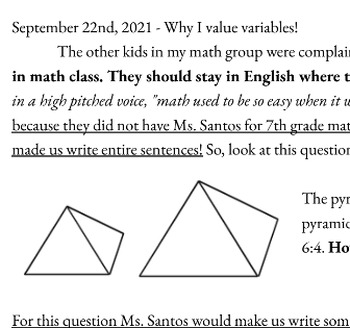Oscar's Diary: Read in 4 voices (the value of variables)
- PDF
Description
If you're not familiar with read in 4 voices, it's a strategy for breaking up text that comes out of EL (english learner) classrooms, but it can be useful for all learners. Each member of a 4 person group reads the parts corresponding to their kind of type (plain text, bold, italics, underlined).
Oscar's Journal entry is about other kids in his class complaining about the use of letters in math class and why he values using variables. I use it with my 9th grade students as a refresher to discuss "what is a variable?" and re-engage their minds in translating from verbal descriptions to algebraic representations. But it could be used with earlier grades and in introducing variables and algebraic expressions for the first time.
[As a side note, Oscar doesn't like his old teacher, Ms. Santos, methodologies. But I'm a huge fan. If there were more elementary and middle school teachers like Ms. Santos, there'd probably be more Oscars by the time they get to me in high school]!
This is a good - easy to implement - resource and strategy if you're being pressed to increase student voices throughout the math lesson.


